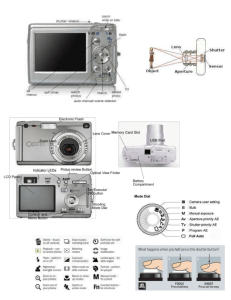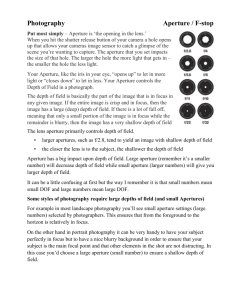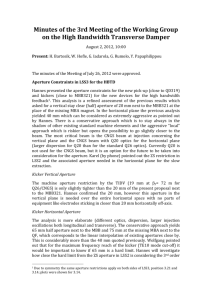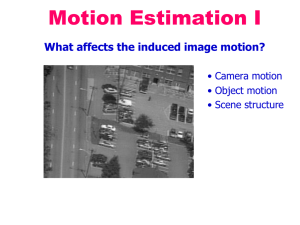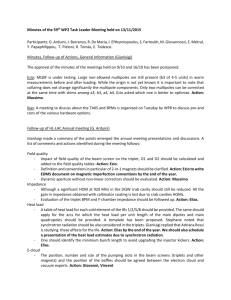Minutes_18072014_GA
advertisement
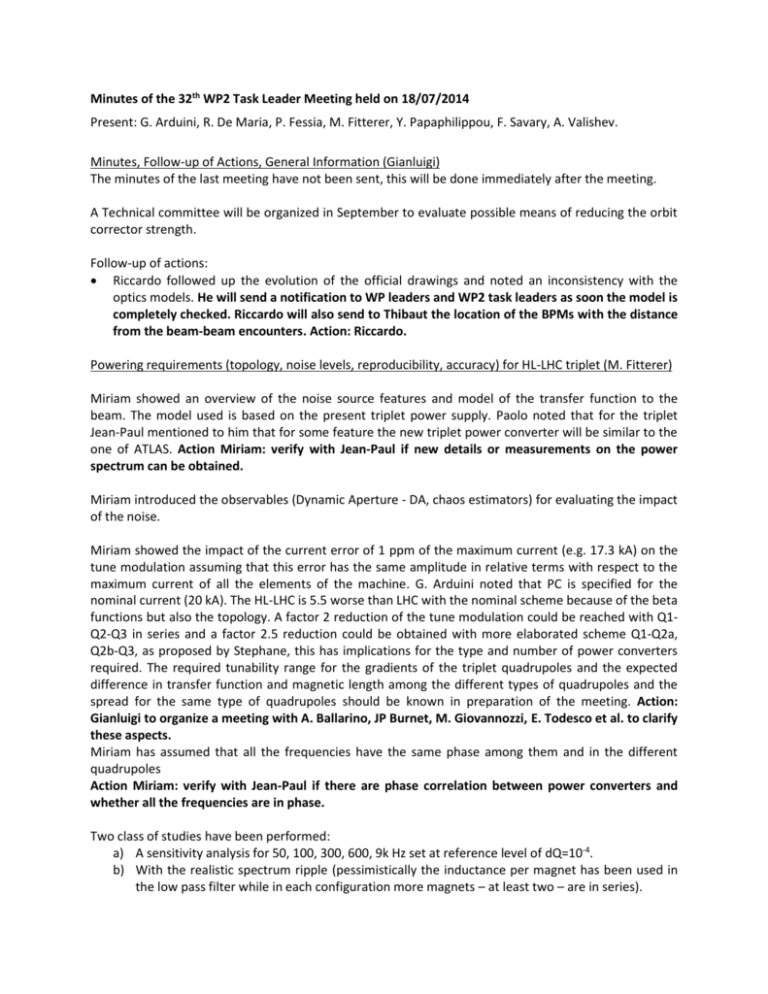
Minutes of the 32th WP2 Task Leader Meeting held on 18/07/2014 Present: G. Arduini, R. De Maria, P. Fessia, M. Fitterer, Y. Papaphilippou, F. Savary, A. Valishev. Minutes, Follow-up of Actions, General Information (Gianluigi) The minutes of the last meeting have not been sent, this will be done immediately after the meeting. A Technical committee will be organized in September to evaluate possible means of reducing the orbit corrector strength. Follow-up of actions: Riccardo followed up the evolution of the official drawings and noted an inconsistency with the optics models. He will send a notification to WP leaders and WP2 task leaders as soon the model is completely checked. Riccardo will also send to Thibaut the location of the BPMs with the distance from the beam-beam encounters. Action: Riccardo. Powering requirements (topology, noise levels, reproducibility, accuracy) for HL-LHC triplet (M. Fitterer) Miriam showed an overview of the noise source features and model of the transfer function to the beam. The model used is based on the present triplet power supply. Paolo noted that for the triplet Jean-Paul mentioned to him that for some feature the new triplet power converter will be similar to the one of ATLAS. Action Miriam: verify with Jean-Paul if new details or measurements on the power spectrum can be obtained. Miriam introduced the observables (Dynamic Aperture - DA, chaos estimators) for evaluating the impact of the noise. Miriam showed the impact of the current error of 1 ppm of the maximum current (e.g. 17.3 kA) on the tune modulation assuming that this error has the same amplitude in relative terms with respect to the maximum current of all the elements of the machine. G. Arduini noted that PC is specified for the nominal current (20 kA). The HL-LHC is 5.5 worse than LHC with the nominal scheme because of the beta functions but also the topology. A factor 2 reduction of the tune modulation could be reached with Q1Q2-Q3 in series and a factor 2.5 reduction could be obtained with more elaborated scheme Q1-Q2a, Q2b-Q3, as proposed by Stephane, this has implications for the type and number of power converters required. The required tunability range for the gradients of the triplet quadrupoles and the expected difference in transfer function and magnetic length among the different types of quadrupoles and the spread for the same type of quadrupoles should be known in preparation of the meeting. Action: Gianluigi to organize a meeting with A. Ballarino, JP Burnet, M. Giovannozzi, E. Todesco et al. to clarify these aspects. Miriam has assumed that all the frequencies have the same phase among them and in the different quadrupoles Action Miriam: verify with Jean-Paul if there are phase correlation between power converters and whether all the frequencies are in phase. Two class of studies have been performed: a) A sensitivity analysis for 50, 100, 300, 600, 9k Hz set at reference level of dQ=10-4. b) With the realistic spectrum ripple (pessimistically the inductance per magnet has been used in the low pass filter while in each configuration more magnets – at least two – are in series). The a) studies show a strong sensitivity for 600 Hz and a visible sensitivity for 300Hz. The b) studies show no visible effect on the DA. Miriam showed DA vs Turns to highlight that the 600 Hz and 300 Hz DA degradation starts below <105 turns. In conclusion if the current spectrum from the model provided by the EPC colleagues is correct no significant effect on dynamic aperture is observed with and without beam-beam. No model of the beam screen is included so far (information is expected from Ezio in that respect). Ripple at 300 Hz and in particular at 600 Hz with amplitude corresponding to a tune modulation amplitude of 10-4 (approximately corresponding to 1 ppm current amplitude modulation with respect to the maximum power converter current rating) has a sizeable effect on dynamic aperture with and without beambeam. A possible configuration reducing the tune modulation amplitude at constant current ripple is proposed and should be evaluated with the relevant WPs. Action Miriam: understand the origin of the larger impact of 600 Hz, 300 Hz on dynamic aperture. After the meeting Stephane commented that the DA simulation with beam-beam should be checked once more to verify whether they were performed with a tune shift of 0.03, i.e. with crabs and IP8. Action for Miriam. Further discussion took place concerning the requirements on the power converters for new and existing elements deriving from the need of minimizing the squeeze time and pre-cycle. Action Riccardo: ask Matteo to provide the current decay time for all classes of magnets. For the new magnets the expected calibration curves should be provided. Action: Ezio. Aperture and orbit correction requirements for the 11 T dipoles (R. De Maria) Riccardo presented three different scenarios for the 11 T dipoles identified by WP5: 1) Post LS2: replacing one TCLD/11 T dipole unit in the DS’s of IR2 2) Post LS3 - A: Post LS2 + two TCLD/11 T dipole units in the DS’s of IR7 3) Post LS3 - B: Post LS3 – A + two TCLD/11 T dipole units in the DS’s of IR1/5 (at the same positions as in IR7 – although this needs to be confirmed by the ion collimation team) Riccardo added that for IR1 and IR5 the magnets to be replaced are identified yet After the meeting Roderik and John confirmed that for ions only one TCLD would be sufficient in IR1 and IR5, while for protons it is unlikely. The main issues for all scenarios are: a) Reduction of the aperture as the MBH are straight instead of bend magnets b) Change of the transfer function, which could be mitigated by installing trim power converters or implementing orbit bumps in the vicinity of the replaced dipoles Riccardo raised the question, if it would be possible to have bent beam pipe inside a straight dipole. Frederic answered that it would be very difficult to keep bent beam pipes inside as it would have to be mechanically fixed in several positions. Following this discussion Gianluigi asked if it would be instead easier to fabricate a larger cold bore to profit of the full magnet coil aperture. Frederic replied that it is not more difficult, but that the difficulty is more the vacuum system for which it is preferred to use standard equipment if possible. This is why the size of the cold bore has not been increased for the new dipoles. There is even an interest to reduce the coil aperture for the 11T dipoles to be produced for installation after LS2. Action Frederic: Study the possibility of larger aperture cold-bore for the 11T dipoles, check mechanical alignment tolerances. For the aperture calculation the nominal aperture margins have been used, which should be updated by the new aperture margins once defined. Riccardo asked to verify the mechanical tolerances. At injection, a relevant reduction of the aperture is observed for IR7 and IR1/5. At collision no significant new bottlenecks is foreseen as the aperture margins in the arcs are in the order of 30-40 σ but for the debris new bottlenecks may be introduced. In general, the current aperture of a straight nominal beam screen aligned with the reference orbit and the same MB tolerances is just compatible with the current aperture model. Similar results are to be expected for the HL-LHC. Riccardo shows the transfer function currently assumed for the 11 T dipoles. One solution to compensate the difference in the transfer function with respect to the standard dipoles is to use an additional trim power converter. If no trim power converters are available orbit bumps have to be used instead. The main issues of the orbit bumps are: 1) 2) 3) 4) Orbit correctors running out of strength or exceeding operational margins Aperture restrictions at injection Eventual interplay with orbit bumps for collimation Operational complexity (one reference needed for each energy and not for each optics) The orbit correctors at Q7-Q10 are used to correct the orbit and a margin based on one typical fill in 2012 has been considered. In the simulations the following dipole errors have been assumed: 50 μrad per MBH is considered constant up to 3.5 TeV and decreases linearly with the energy to 0 at 7 TeV. A degradation of the aperture is visible at injection in some locations in IR2 and IR7. At collision the impact of any residual orbit should be checked by collimation as it may affect the trajectory of diffracted particles. Furthermore operation and machine protection studies are needed to validate any operation with bumps. After the meeting Riccardo verified with Frederic and Mikko the hypothesis on the transfer function error. The possible error to be expected can be approximated by: a) 100 μrad at 3.5 TeV and 0 at 7TeV b) 50 μrad at 3.5 TeV and -50 μrad at 7 TeV For both these options no sufficient margin in corrector strength is left based on 2012 experience as shown in the Table below. This can only be partly recovered with intermediate error functions leaving modest operational margins. 3.5 TeV OP value MCBC [% of max current] 30 μrad 7 TeV 25% 60 μrad Margin on top of ideal fills 50% Option talk 50 μrad 40% 0 0 +50% Option a) 100 μrad 80% 0 0 -5% Option b) 50 μrad 40% -50 μrad 80% -30% Option c) 77 μrad 62% -23 μrad 37% +12% Action Riccardo: Recheck with Joerg the assumed corrector strength budget for orbit correction is representative. Gianluigi asks if the aperture reduction due to the orbit bumps is included in the loss map simulations performed by the collimation team (after the meeting Riccardo checked that reductions due to bumps and/or straight aperture were not included). Gianluigi also comments, that in case of failure of one orbit corrector, not enough corrector strength would be available and thus it would need to be immediately repaired with consequent reduction in availability. Based on the above results it was concluded that: Trim power converter is necessary The use of a non-standard large aperture cold bore to profit of the full coil aperture is recommended. Next meeting will take place on Friday 15th August 2014 at 16:00. Reported by Gianluigi, Riccardo, Miriam.

